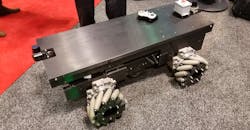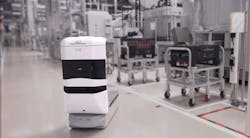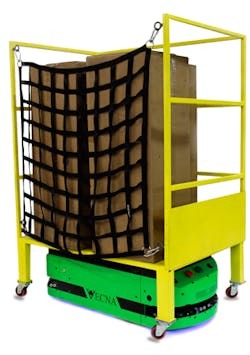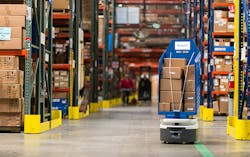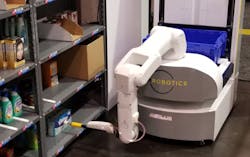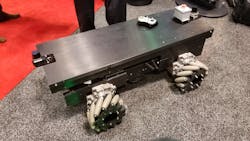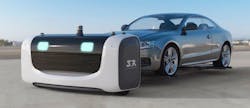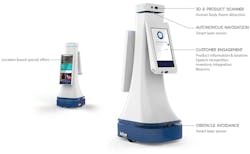Self-driving cars have certainly reaped the rewards from the advances made in sensors, processing power, and artificial intelligence, but they aren’t the sole beneficiaries. One needn’t look any further than to the autonomous cooperative robots (cobots) currently invading the warehouses and stores in which they will work in close quarters with people.
Wandering around this year’s Robobusiness was more interesting, since one had to dodge robots in addition to people. This isn’t necessarily new for a robotics show, but some of these robots were a bit bigger and moving more massive objects around without being cordoned off. Some can move over half a ton of equipment or materials. They may not run as fast as a self-driving car; however, it’s hard to argue with mass and momentum, so safety is as critical for these slower moving robots as it is for cars.
A number of vendors at the Robobusiness show displayed their wares for warehouses, including Aethon, I Am Robotics, Fetch Robotics, and Vecna Robotics, with others providing related support. Soon it may be typical to see a robot wandering the halls picking up and leaving behind materials for us humans to use.
1. Aethon’s latest TUG is festooned with sensors and can fit under carts to tow them to desired locations.
Aethon’s TUG (Fig. 1) is the latest in a line of autonomous robots designed for environments like warehouses. It has more sensors on it than older platforms, which is indicative of the falling price of sensors, improvements in sensor integration, and use of artificial intelligence to process the additional information. This allows robots like this to get a better model of the surrounding environment. It means the robots operate more safely, since they can better recognize people and objects. It also means they can perform their chores more effectively, because they often need to interact with these objects.
Aethon’s TUG series provides a range of capabilities up to versions that can haul around as much as 1200 lbs. These typically find homes in industrial and manufacturing environments. Smaller TUGs have been set up in hospitals to deliver medicine, meals, and materials. TUGs move throughout a hospital calling elevators and opening doors via network connections. As with warehouse robots, they operate around the clock doing jobs that allow others to do theirs.
2. The RL350 robotic lifter from Verna Robotics rises under a cart and lifts 350 kg off the ground. It then delivers the contents to the desired location, dropping down and leaving the cart.
Sponsored Assets:
- Robotics, machine learning power autonomous systems
- Podcast: Smart robots and machine learning drives collaboration, continual improvement
- Ultra-Small IO-Link Sensor Transmitter with RTD Front End Reference Design
Vecna Robotics has lightweight and heavy-duty robots, too. Its RL350 robotic lifter can hoist 350 kg or more than 770 lbs (Fig. 2). It can also adjust the payload height with other pieces of material-handling equipment, like conveyor belts. It can be used in applications such as fulfillment operations or lineside supply. The robot has a top speed of 2 m/s, and can run for eight hours before seeking out a charging station. It is ANSI/ITSDF B56.5 compliant and ISO Class D ready. It uses LIDAR and ultrasonic sensors like many of the other robots in this class.
3. Fetch Robotics’ VirtualCoveryor targets warehouse applications such as DHL’s distribution center.
Fetch Robotics has a range of products, from robotic arms for research to its datasurvey inventory robot. It also offers the VirtualCoveryor (Fig. 3), which comes in a number of different sizes to address different weight configurations. The Freight500 can move up to 500 kg, while the Freight1500 handles up to 1500 kg. They run up to nine hours on a charge, and incorporate LIDAR and 3D cameras on the front and rear. As with most warehouse robots, Fetch Robotics delivers them with its FetchCore Management software.
I Am Robotics includes a robotic arm on its I Am Swift platform (Fig. 4). It can run for more than 10 hours picking and placing small objects using its suction grip. The typical boxes or bottles found on store shelves are open game. The robot is designed to work with the I Am SwiftLink software.
4. I Am Robotics put a robotic arm on its I Am Swift platform. The suction grip is designed for grabbing lightweight objects that would be typical in many warehouse pick-and-place environments.
The I Am Flash 3D scanner is used to teach the system about objects that will be manipulated. It records the barcode, object dimensions, and weight after an object is placed in its scanning area. The I Am Swift robot can then determine what objects it sees on a shelf or in its basket and move them accordingly.
Unique Robotic Mobility
Stanley Innovation was showing off some of its hardware at Robobusiness, including a platform that can be use in a warehouse (Fig. 5). The trick is that it utilizes omnidirectional wheels in order to move literally in any direction from a standing start. This simplifies path planning and allows it to work in tight quarters.
5. Omnidirectional wheels on Stanley Innovation’s robot platform make it easy to move in tight quarters.
The latest offering from Stanley Robotics was not able to fit on the show floor, though. Its Stan valet parking system (Fig. 6) turns any car into a self-driving car, at least to park it. It rolls under a typical car and then raises itself, thereby lifting the car. Many warehouse robots that lift carts instead of cars use an identical technique—it’s the same idea, but applied to a much larger object.
6. Stan from Stanley Robotics handles valet parking by literally picking up a car and putting in a parking spot.
Inventory Robots
Fellows Robots’ NAVii (Fig. 7) is designed to operate within a store, providing customers with information while performing inventory scanning. It can map out a store on its own and then track the stock using machine-learning techniques. NAVii will notify store managers when stock is low, or if there are price discrepancies.
7. Fellows Robots’ NAVii will function within a store, offering information to customers while performing inventory scanning.
NAVii can also interact with store customers using its display panels. On top of that, store employees can take advantage of this mobile interface to interact with the store’s computer network. As with most autonomous robots, it seeks out a charger when its battery runs low.
Sponsored Assets:
About the Author
William G. Wong
Senior Content Director - Electronic Design and Microwaves & RF
I am Editor of Electronic Design focusing on embedded, software, and systems. As Senior Content Director, I also manage Microwaves & RF and I work with a great team of editors to provide engineers, programmers, developers and technical managers with interesting and useful articles and videos on a regular basis. Check out our free newsletters to see the latest content.
You can send press releases for new products for possible coverage on the website. I am also interested in receiving contributed articles for publishing on our website. Use our template and send to me along with a signed release form.
Check out my blog, AltEmbedded on Electronic Design, as well as his latest articles on this site that are listed below.
You can visit my social media via these links:
- AltEmbedded on Electronic Design
- Bill Wong on Facebook
- @AltEmbedded on Twitter
- Bill Wong on LinkedIn
I earned a Bachelor of Electrical Engineering at the Georgia Institute of Technology and a Masters in Computer Science from Rutgers University. I still do a bit of programming using everything from C and C++ to Rust and Ada/SPARK. I do a bit of PHP programming for Drupal websites. I have posted a few Drupal modules.
I still get a hand on software and electronic hardware. Some of this can be found on our Kit Close-Up video series. You can also see me on many of our TechXchange Talk videos. I am interested in a range of projects from robotics to artificial intelligence.
